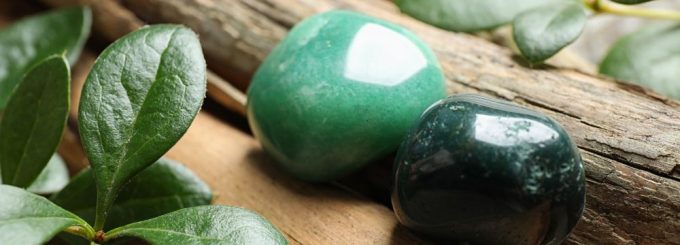Gemstone Spotlight: Aventurine

Aventurine is a type of quartz gemstone that is prized for its sparkle, metallic inclusions and translucency. Muscovite mica is one of its key ingredients, which gives it a green, blue or silver sheen. It produces an amazing effect called aventuresence that separates it from other stones.
Characteristics
This gem will usually display a green color, similar to jade. However it is darker and the result of trace fuchsite elements in quartz that would otherwise be colorless. It is identified and distinguished due to its aventuresence, which has varying levels of intensity. The intensity is determined by the size and density of the metal inclusions.
Many aventurine stones appear banded and will display distinctive dark and light color zones. Although this stone manifests a texture which is grainy in its natural state, when polished it will transform into a soft, beautiful and lustrous gem. Aventurine can be found in multiple regions of the world, including Tanzania, India, Chile, Austria, Brazil and Russia.
It was rediscovered by accident in the 18th century by glass workers, but research indicates that this stone was known to the ancients and was used by them to produce tools. It is well suited to this task since aventurine is durable yet isotropic and brittle which enables it to be easily shaped.
How To Shop For Aventurine
When shopping for aventurine you’ll want to pay attention to the color, luster, clarity, shape and cut. While this stone is most famous for its green coloration, it can appear in other colors such as blue, red, brown and yellow. Despite this, green aventurine is usually the most expensive and sought after variety.
Most jewelers will cut aventurine into a cabochon shape. It can also be carved into ornaments or animal shapes. Some experts like to drill it into gemstone beads, and other shapes that it might appear in include ovals, rounds, cushions, pearls, hearts and trillions. Unlike other stones, it is not necessary to treat it, and this makes it simple to work with.
The best types of jewelry for aventurine include bracelets, brooches, necklaces and anything with strands or beads. It is also used in pendants and cabochon rings. When purchasing colored stones, be sure to always make your selection based on the size rather than carat weight. The reason for this is because colored stones will vary in their weight to size ratio, with some specimens being larger while others have a smaller size that is comparable to diamonds.
How To Care For Aventurine
Aventurine is simple to maintain. To clean it all you need is warm and soapy water with a brush or cloth that is soft. Although this stone has a Moh’s scale hardness rating of 7, which is high, you should be careful when storing it near other items, since some gems are even harder and could damage it. Avoid using harsh chemicals or exposing it to excessive heat. It should be stored in a box lined with fabric.


